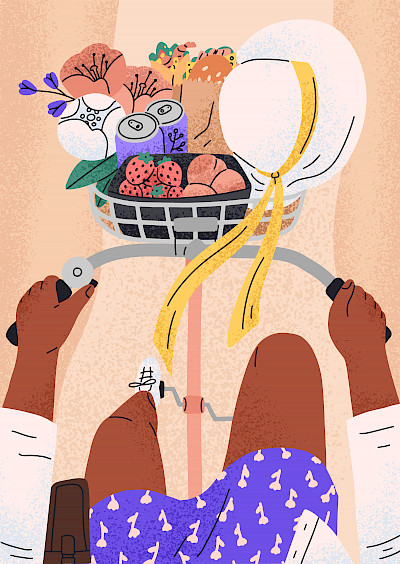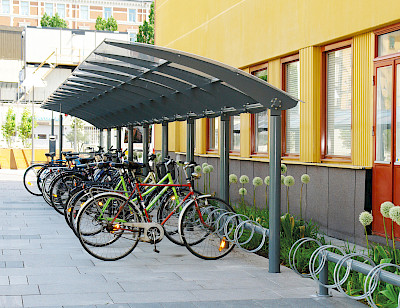Seagull
Bike Shed
Seagull is a durable bicycle shed, elegantly designed in the shape of a bird's wing. The bicycle shed is available in both single- and double-sided versions in three standard lengths, with or without glass gables or back panels.
2021–09–22
As municipalities around the world develop bicycle infrastructures, they’re investing in the environment and boosting public health too. Although the benefits of urban cycling are easy to understand, leading experts claim that there is not enough awareness around them. They say that it is time to break the vehicle norm, and introduce urban cycling to create a complete and lasting change.
Anyone commuting by bicycle or taking walks along city streets, forest paths or rural roads has probably noticed that the number of cyclists has increased significantly in recent years.
Many cyclists claim that it is almost impossible to buy reasonably-priced bicycles today. The cost of new and second-hand cycles has drastically increased. So what's going on? According to bicycle industry statistics, the sale of cycles to consumers has increased by as much as 30 percent in the past year. This is attributed to a general shift in travel patterns, as well as the short-term impact of the pandemic. It reflects greater environmental awareness, but also an increased interest in traditional cycling, electric cycling and mountain-biking.

"For every euro invested in bicycle infrastructures, you get more money back. In other words, a pure socio-economic profit that is good for public health and the environment too."
Jeanette Nilsson, landscape architect and founder of Edge
As more urban dwellers start cycling, they pave the way for new infrastructure developments. The European Cycling Federation has announced that approximately one in three major European cities introduced new measures to facilitate cycling during the pandemic. Paris holds the lead in green city development, followed closely by Copenhagen and Amsterdam, two cities where cycling has long been part of the culture. Sweden, however, is lagging behind.
“Positive development takes place all the time in Sweden, but in general, there isn’t enough awareness of the benefits of cycling,” says Jeanette Nilsson, a landscape architect and founder of landscape architecture practice Edge. “For every euro invested in bicycle infrastructures, you get more money back. In other words, a pure socio-economic profit that is good for public health and the environment too.”
Jeanette considers cycling to be a hot issue today, and one that is creating a watershed moment within urban development. She believes that to achieve the UN climate goals, municipalities will have to look beyond four-year development windows and think more about collective benefits rather than individual opinions.
“We have to make a total change within our cities,” explains Jeanette. “By investing in bicycle infrastructures, we’ll be able to replace conventional traffic and therefore reduce the vehicle footprint. The process makes cities more vibrant and attractive as it reduces congestion, air pollution and noise.”
Edge is located in the southern Swedish city of Malmö, where sustainable travel is a cornerstone of the city’s future development. Edge is passionate about protecting the environment, which is reflected in the company’s mandate to contribute to positive climate impact. They have developed an ‘environmental perk’ that gives employees a salary bonus if they choose green transport to commute to and from the workplace.

During the pandemic, many European cities encouraged cycling by introducing measures to promote it. Safety, accessibility, cycle parking and weather-protection are important aspects. This is the Seagull bicycle shelter.
When bicycle lanes are built, the environmental benefits come automatically. In rain beds, greenery can spread underneath paved surfaces and create better ecosystems around them. Photo: Edge

Martin Vysoký is a landscape architect at Edge as well as a cycling enthusiast who believes that municipalities can’t afford not to invest in cycling. In his experience, when new cycle paths are built, or old streets are converted into cycle lanes, the environmental benefits come automatically. Cycle lanes can be combined with multifunctional surfaces such as rain beds that enable plants to spread beyond paved surfaces and therefore create better ecosystems around them. They purify rainwater and neutralize air pollution. This approach has already been tested by Edge in cities such as Vellinge near Malmö, and in Rosendal near Uppsala.
“Using a multi-functional rain bed to separate a cycle lane from a road for vehicles is a way to create benefits for both man and nature,” says Martin. “Tree roots can spread and rainwater can be purified and stored in an open reinforcement layer created underneath a rain bed or cycle path.”

This illustration shows an example of a multifunctional surface: a rain bed in combination with a cycle lane. Illustration: Edge
Cycling inspires many creative solutions and can impact on other urban systems. "When properly managed, cycling is an expression of the modern city," wrote Veronica Hejdelind in Arkitekten magazine. She claims that when cities invest successfully in cycling infrastructures, they experience benefits beyond accessibility and safety. Cycling can reinforce a local identity and contribute to building a sustainable community.
Benefits like these are not overlooked by Jeanette or Martin, who both point out that as bicycle infrastructures develop, space needs to be made available for them. This means creating space for safe storage on the street, cycle parking areas and systems for loaning and sharing bicycles.
The rise of traditional cycling is paralleled by the increasing use of electric scooters. They are often considered to be controversial, leading some experts to question if they should be banned. Others believe that they provide a good solution, and that the streets and cities of the future should be planned to make room for them. Either way, future cities will have to find a sustainable means of transportation that replaces cars altogether.
These can include roofs for bicycle shelters that encourage pants to grow on them. Space-saving vertical bicycle parking areas can be constructed at shopping centers, sports arenas, universities and other places that attract large crowds. Even on a smaller scale, the need for more bicycle racks, pedestrian bollards and rest stops for cyclists will need to be considered.

Cities that successfully invest in cycling lay the foundation for cultural as well as health-promoting benefits. This our cycle support bollard Biker’s Rest.
Revet bicycle shelter has a multi-functional roof that provides protection from sun and rain. It provides parking space for cycles and scooters.


Cycle racks at entrances to offices and schools cmake it easier and more attractive to choose the bicycle instead of cars. Here, Snøhetta's cycle shelter Våg was installed outside the MAX IV Lab in Lund, Sweden (see more in the Project section).
Agneta Stake, founder and product development manager at Nola, is involved in several urban cycling projects. “At Nola, we’re constantly in dialogue with various cities about cycling issues and the development of new prototypes,” she explains. “It’s an exciting job. We are constantly working to be one step ahead.”
To move forward, everyone involved has to contribute to making cycling as viable as possible, making it the first and obvious choice. “There is a strong car norm in Sweden that we have to break away from,” says Jeanette. “Above all, it’s a matter of raising public awareness about how beneficial cycling is. It is also important to situate cycle parking spaces close to entrances and offer covered parking for them. The goal has to be to choose the bike because it is the easiest option.”
“The goal has to be to choose the bike because it is the easiest option.”
Jeanette Nilsson, landscape architect and founder of Edge